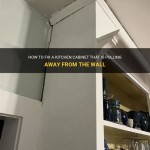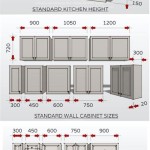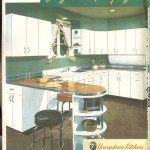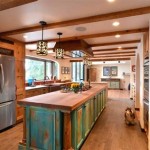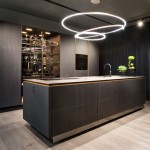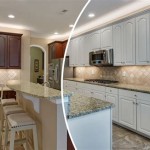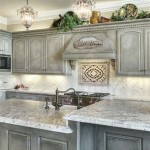How To Tell What Kind of Kitchen Cabinets I Have
Determining the type of kitchen cabinets present in a home is a crucial step in maintenance, renovation, or even when simply desiring a stylistic update. Understanding the construction, style, and door type provides a foundation for informed decisions regarding repair, replacement, or refinishing. This article outlines the key factors to consider when identifying the components of kitchen cabinetry.
Examining Cabinet Construction: Framed vs. Frameless
One of the primary distinctions to make when identifying kitchen cabinets is whether they are framed or frameless. This refers to the presence or absence of a face frame, which is a supporting structure attached to the front of the cabinet box.
Framed Cabinets: These cabinets feature a frame typically made of wood that is attached to the front of the cabinet box. This frame provides stability and a surface for attaching doors and drawers. The frame also creates a slightly recessed look compared to the doors. Variations in framed cabinets exist, primarily categorized as full overlay, partial overlay, and inset.
Partial Overlay: In this type, a portion of the face frame is visible around the doors and drawers. This creates a traditional appearance and is often more economical in terms of material usage. The amount of frame that is visible can vary depending on the manufacturer and style.
Full Overlay: With full overlay cabinets, the doors and drawers almost completely cover the face frame, leaving only a small gap between them. This provides a more modern and streamlined appearance while still maintaining the structural integrity of a framed cabinet.
Inset: Inset cabinets feature doors and drawers that fit flush within the frame. This requires precise construction and hardware, contributing to a higher price point. The result is a clean, sophisticated look that highlights the craftsmanship involved.
Frameless Cabinets: Also known as European-style cabinets, frameless cabinets lack the face frame found in traditional framed construction. The doors attach directly to the cabinet box. This design emphasizes clean lines and maximizes interior storage space because there is no frame to obstruct access. The thickness of the cabinet box material is crucial for structural integrity in frameless construction, typically utilizing thicker plywood or MDF.
To identify whether cabinets are framed or frameless, open a cabinet door and examine the front edge of the cabinet box. If a wood frame is visible, the cabinet is framed. If the door hinges are attached directly to the side of the cabinet box without a frame, it is frameless.
Identifying Cabinet Door Styles
The style of the cabinet door significantly impacts the overall aesthetic of a kitchen. Several door styles are prevalent, each offering a distinct look and feel. Recognizing these styles is key to determining the type of kitchen cabinets present.
Shaker: Shaker-style doors are characterized by a five-piece construction consisting of a flat center panel surrounded by a frame. The frame is typically a simple, clean design with square edges. Shaker cabinets are versatile and can be used in both traditional and modern kitchens due to their understated elegance.
Flat-Panel or Slab: These doors are plain and feature a single, flat panel. They are commonly found in modern and contemporary kitchens and are appreciated for their minimalist aesthetic. Slab doors can be made from various materials, including wood, laminate, or metal.
Raised-Panel: Raised-panel doors feature a center panel that is raised above the surrounding frame. This creates a more dimensional and decorative appearance compared to flat-panel or Shaker doors. Raised-panel doors are often used in traditional or formal kitchens.
Recessed-Panel: These doors, conversely, have a center panel that is set below the surrounding frame, creating a recessed design. While similar to Shaker-style, recessed-panel doors can incorporate more decorative detailing or molding within the recess.
Glass-Front: Glass-front cabinets feature doors with glass panels, allowing visibility into the cabinet's interior. These cabinets are often used to display decorative items or dishware. Various types of glass can be utilized, including clear, frosted, seeded, or leaded glass, each offering a different level of opacity and visual texture.
Louvered: Louvered cabinet doors feature horizontal wooden slats, similar to those found in shutters. This style provides ventilation and adds a textural element to the kitchen. Louvered doors are commonly used in areas where airflow is desired, such as pantry cabinets or appliance garages.
Beadboard: Beadboard doors feature vertical planks with a small groove or bead between each plank. This style adds a rustic or country-inspired feel to the kitchen. Beadboard can be incorporated into the entire door or as a decorative panel within a framed door.
Determining Cabinet Materials and Finishes
The materials used in cabinet construction and the applied finishes influence the durability, appearance, and cost of the cabinets. Identifying these aspects provides crucial information about the quality and longevity of the kitchen cabinetry.
Wood: Solid wood cabinets are considered a high-end option, appreciated for their natural beauty and durability. Common wood species used in cabinet construction include maple, oak, cherry, birch, and walnut. Each wood species has its own distinct grain pattern and color, influencing the overall aesthetic. Wood cabinets can be stained or painted to achieve the desired finish.
Plywood: Plywood is an engineered wood product made from layers of wood veneer glued together. It is a stable and durable material commonly used for cabinet boxes and sometimes for door panels. Plywood is less prone to warping or cracking compared to solid wood, making it a reliable choice for cabinet construction.
Medium-Density Fiberboard (MDF): MDF is another engineered wood product made from wood fibers and resin. It is a smooth, consistent material that is well-suited for painting. MDF is often used for cabinet doors and drawer fronts due to its ability to be shaped and molded into intricate designs. However, MDF is more susceptible to damage from moisture compared to solid wood or plywood.
Particleboard: Particleboard is a less expensive engineered wood product made from wood chips and resin. It is less dense and durable than plywood or MDF and is more prone to damage from moisture. Particleboard is typically used for cabinet boxes in budget-friendly cabinet options.
Laminate: Laminate cabinets feature a thin layer of decorative laminate bonded to a substrate, such as particleboard or MDF. Laminate is a durable and easy-to-clean material that is available in a wide range of colors and patterns. Laminate cabinets are a cost-effective option for achieving a modern or contemporary look.
Thermofoil: Thermofoil cabinets feature a thin layer of vinyl thermofoil wrapped over an MDF core. Thermofoil provides a seamless and durable finish that is resistant to scratches and stains. However, thermofoil can be susceptible to heat damage, potentially peeling or bubbling near ovens or dishwashers.
Finishes: The finish applied to cabinets contributes significantly to their appearance and protection. Common cabinet finishes include paint, stain, and varnish.
Paint: Painted cabinets offer a wide range of color options and can be used to create a variety of styles. Paint provides a durable and protective finish that can be easily cleaned. Different types of paint can be used, including latex, acrylic, and oil-based paints, each with its own characteristics in terms of durability and sheen.
Stain: Stained cabinets highlight the natural grain of the wood and add warmth and depth to the kitchen. Stains are available in a variety of colors, ranging from light to dark. After staining, a clear topcoat, such as varnish or lacquer, is typically applied to protect the stain and provide a durable finish.
Varnish: Varnish is a clear protective coating that can be applied over wood or paint. It provides a durable and glossy finish that is resistant to scratches and moisture. Varnish is available in different sheens, ranging from matte to high-gloss.
To determine the material and finish of your cabinets, closely examine the surfaces of the doors, drawers, and cabinet boxes. Look for wood grain patterns, seams, or variations in color. Consider the overall feel and weight of the materials. If unsure, consulting with a cabinet professional or contractor can provide further clarification.
Assessing Hardware and Details
While often overlooked, cabinet hardware such as handles, knobs, and hinges can provide clues about the age, style, and quality of the cabinets. Similarly, subtle details like molding, trim, and decorative elements can further refine the identification process.
Hardware Styles: Cabinet hardware comes in a variety of styles, ranging from traditional to modern.
Traditional: Traditional hardware often features ornate designs, such as scrolls, curves, or floral motifs. Common materials include brass, bronze, and antique finishes.
Modern: Modern hardware is characterized by clean lines, minimalist designs, and sleek finishes. Common materials include stainless steel, chrome, and brushed nickel.
Transitional: Transitional hardware blends elements of both traditional and modern styles, offering a versatile look that can complement a variety of kitchen designs.
Hinge Types: The type of hinges used on cabinets can also provide information about their construction and style.
Concealed Hinges: These hinges are hidden from view when the cabinet door is closed, providing a clean and seamless look. Concealed hinges are commonly used in frameless cabinets and full overlay framed cabinets.
Exposed Hinges: These hinges are visible on the exterior of the cabinet and can add a decorative element to the overall design. Exposed hinges are often used in traditional or vintage-inspired kitchens.
Decorative Details: Molding, trim, and other decorative elements can enhance the appearance of cabinets and provide clues about their style.
Crown Molding: Crown molding is installed at the top of the cabinets, adding a decorative finishing touch. Crown molding can be simple or elaborate, depending on the desired style.
Light Rails: Light rails are installed under the upper cabinets to conceal under-cabinet lighting. They can also add a decorative element to the kitchen.
Decorative Legs: Decorative legs can be added to base cabinets to create a furniture-like appearance. They are often used in traditional or country-style kitchens.
By carefully examining the hardware and decorative details of your cabinets, you can gain further insight into their style, age, and quality. This information can be valuable when considering renovations, repairs, or replacements.

9 Diffe Types Of Kitchen Cabinets You Must Know

Types Of Cabinet Door Styles Cabinetdoors Com

13 Types Of Kitchen Cabinets Must Know Guide

Types Of Kitchen Cabinets 101 Guide For Homeowners

Types Of Kitchen Cabinets Guide Nicholas Carpentry

Types Of Kitchen Cabinets 101 Guide For Homeowners

Kitchen Cabinet Wood Types

8 Diffe Types Of Kitchen Cabinets You Ll Love

Kitchen Cabinet Parts Terminology Granite Quartz Countertops Cabinets Factory

Types Of Kitchen Cabinets 101 Guide For Homeowners
Related Posts

